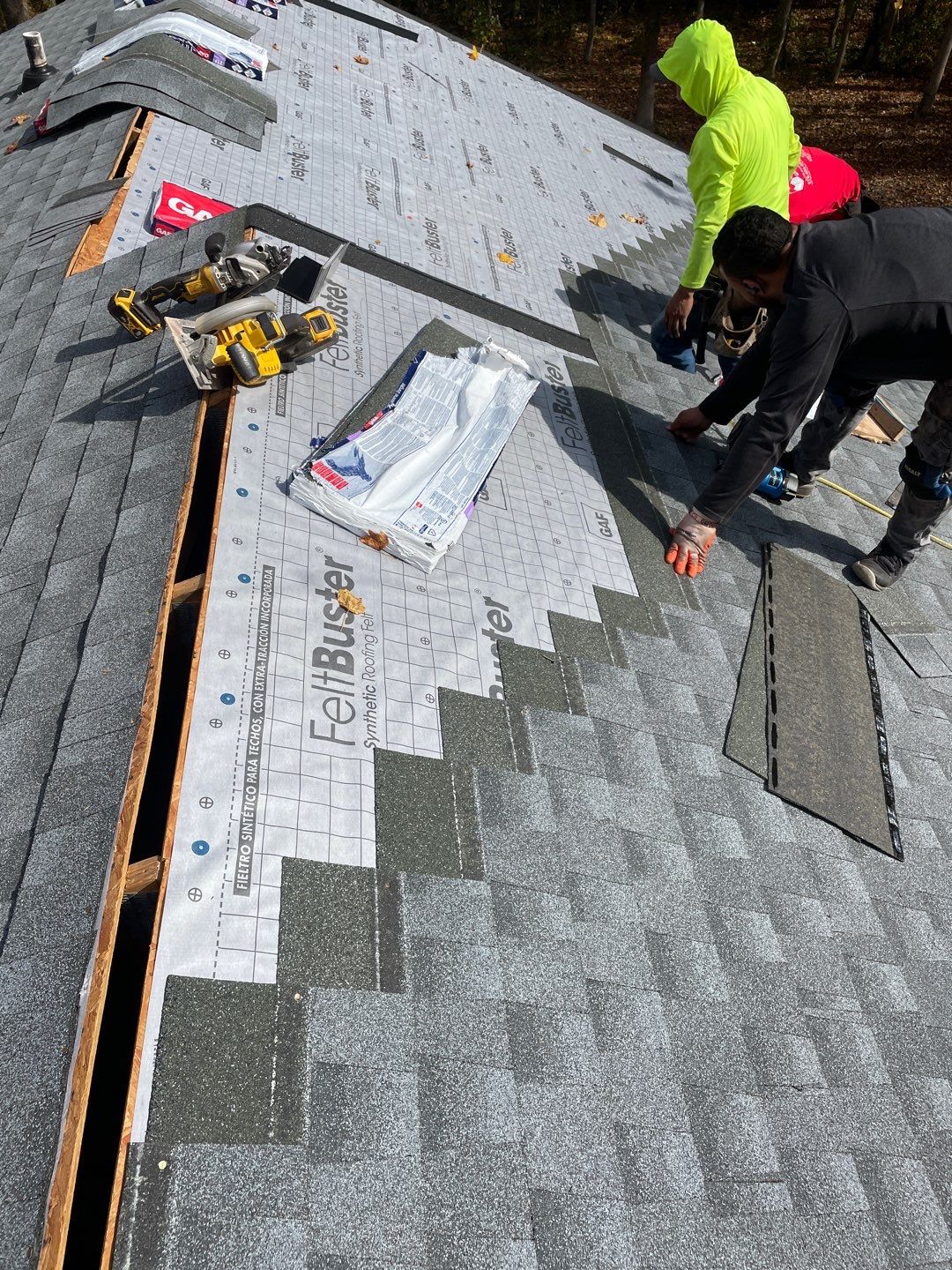Individual Reviews on the very best Gainesville FL Roofing Companies Offered
Individual Reviews on the very best Gainesville FL Roofing Companies Offered
Blog Article
Best Practices for Ensuring Appropriate Roofing Ventilation
Ensuring proper roof ventilation is important for the longevity and efficiency of a roof. A balanced intake and exhaust air vent proportion, generally 1:300, plays a pivotal duty, with intake vents ideally positioned at the reduced edge of the roof covering for trendy air entrance and exhaust vents at the peak for warm air departure. Routine examinations to identify obstructions and maintain clear air flow are critical. Maintaining insulation away from vents is critical to stop airflow restriction. Recognizing these fundamental aspects sets the stage for more thorough understandings into installation and upkeep methods that can considerably enhance your roof's efficiency.
Understand Air Flow Fundamentals
Effectively comprehending air flow fundamentals is important for making sure the durability and performance of roof. Effective ventilation mitigates dampness buildup and temperature level extremes in the attic room, both of which can result in considerable architectural damage gradually. A well-ventilated roofing helps in stopping common problems such as mold development, timber rot, and ice dams, which can compromise the integrity of the roof products and the underlying structures.
The key goal of air flow is to promote the movement of air, allowing for a regular exchange between the outdoor and interior atmospheres. This equilibrium is achieved via a combination of intake and exhaust vents that interact to preserve optimal air flow. Consumption vents, commonly located along the eaves or soffits, allow fresh air to get in the attic room, while exhaust vents, often situated at or near the roofing ridge, allow hot, damp air to leave.
Secret factors affecting the effectiveness of roofing ventilation include proper positioning, sufficient sizing, and making certain that both consumption and exhaust vents are unblocked. Normal assessment and maintenance are critical to determine potential clogs, damage, or inefficiencies in the air flow system, consequently safeguarding the roofing system's performance and longevity.
Types of Roofing Vents
Roof vents play a vital function in maintaining efficient attic room ventilation and, by extension, the overall health of the roof. Various kinds of roof covering vents are available, each with one-of-a-kind advantages customized to specific roof needs. Ridge vents, for instance, are set up along the roofing system's optimal, permitting warm, moist air to leave from the attic room. They supply continual air flow and mix effortlessly with the roofline, making them both reliable and aesthetically pleasing.

Soffit vents are mounted under the eaves and operate in tandem with roofing vents to ensure a well balanced intake and exhaust system. By permitting cooler air to enter from below, soffit vents assist in the expulsion of warm air with upper vents. Gable vents, situated on the outside wall surfaces of the attic room, deal one more efficient service, particularly in homes with saddleback roofs.
Analyze Your Existing Ventilation

Following, consider the age and problem of your roof products and air flow elements. Older systems may not abide by existing building regulations or might have degraded over time, lowering their effectiveness. Conduct a detailed exam to identify any kind of signs of damage, such as corrosion, damages, or spaces that could compromise the system's efficiency.
Furthermore, measure the attic temperature level and humidity levels. Heats and humidity can suggest insufficient air flow - roofing companies in gainesville florida. Make use of a hygrometer and thermometer to get accurate readings, contrasting them with outside problems. Relentless discrepancies suggest prospective problems that need dealing with.
Installation Best Practices
Efficient installment of roofing ventilation systems is critical for making sure optimum efficiency and long life. Proper installation starts with comprehending the particular air flow requirements of the roofing and the building it covers. This involves calculating the appropriate ratio of intake to wear down vents, usually adhering to the 1:300 policy, which states one square foot of air flow for every single 300 square feet of attic flooring space.

The positioning of vents is equally vital. Intake vents must be set up at the roof covering's lower side, often in the soffits, to allow amazing air to go into. Exhaust vents, on the various other hand, ought to be set up near or at the roof's optimal to facilitate the review exit of warm, damp air. This creates an all-natural air movement that helps keep temperature level and dampness balance within the attic room space.
Seal all air vent links thoroughly to avoid air leaks and prospective water seepage. Usage premium products and adhere to manufacturer guidelines to make certain toughness and effectiveness. Additionally, integrating ridge vents with baffles can considerably enhance air movement efficiency by avoiding wind-driven rain and snow from going into the attic.
Inevitably, exact installment of roof ventilation systems alleviates potential problems such as mold development, ice dams, and structural damage, making sure the roof covering's stability and the building's overall health.
Normal Upkeep Tips
Consistency in upkeep methods is basic to making certain the long-lasting efficiency of roof covering air flow systems. Throughout these evaluations, make certain that vents are complimentary of debris, nests, and various other obstructions that can hinder air flow.
Cleaning the vents is one more vital job. Use a soft brush or a vacuum cleaner to eliminate dust and particles from consumption and exhaust vents. Be cautious not to damage the air vent displays or louvers during the procedure. Additionally, inspect the attic area for any kind of indications of water damages, which can jeopardize the stability of the roof.
Correct insulation is equally crucial. Ensure that attic room insulation does not block the vents, as this can seriously limit air movement. Reposition or change it to preserve a reliable barrier. if any kind of insulation has actually changed or settled.
Last but not least, change any damaged or missing elements without delay. Broken vents, cracked tiles, or deteriorated flashing next can all contribute to poor air flow and needs to be addressed right away. Normal maintenance guarantees that the roof covering ventilation system functions ideally, thereby prolonging the life-span of the roof itself.
Final Thought
Making sure appropriate roofing air flow is extremely important for preserving the performance and longevity of a roof system. Adherence to the 1:300 consumption and exhaust vent proportion, combined with the calculated positioning of vents, is crucial. Regular semiannual evaluations, particles cleansing, and making sure insulation does not block air movement are critical practices. Executing these ideal methods will promote a well-ventilated roof, thereby mitigating possible problems associated with moisture buildup and extreme warm, eventually extending the roofing's life-span.
A balanced intake and exhaust vent proportion, typically 1:300, plays a crucial duty, with consumption vents ideally positioned at the reduced side of the roof covering for cool air entry and exhaust vents at the height for warm air exit. Consumption vents, normally situated along the soffits or eaves, enable fresh air to go into the attic area, while exhaust vents, typically located at or near the roofing system ridge, enable hot, humid air to get away.
Soffit vents are set up under the eaves and job in tandem with roof vents to guarantee a well balanced intake and exhaust system. By allowing cooler air to enter from below, soffit vents promote the expulsion of warm air via upper vents. Adherence to click over here now the 1:300 consumption and exhaust vent proportion, combined with the critical placement of vents, is crucial.
Report this page